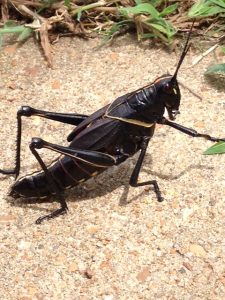 Black Vulture (Coragyps atratus)
Black Vulture (Coragyps atratus)
The black vulture is one of the larger bird residents of the Field Station with a length of 56–74 cm (22–29 in) and a wingspan of 1.33–1.67 m (52–66 in). Its feathers are primarily black. The head and neck are featherless and the skin a very wrinkled dark gray. Interestingly the nostrils of the black vulture are not divided by a septum, so that you can see through the beak. The wings are broad but relatively short. The bases of the wing feathers are white, producing a white patch on the underside of the wing’s edge. The tail is short and square. Because the wings are shorter that most vultures the black vulture flaps its wings while soaring more than others. The black vulture lays its eggs on the ground in wooded areas, caves, or a hollow log, typically less than 3 m (9.8 ft) off the ground. Our vulture chick see in the phot was found in an old camper trailer on the Field Station. Because it lacks a syrinx, the black vulture can’t sing like other birds. It is generally silent, but can make hisses and grunts when agitated or while feeding.
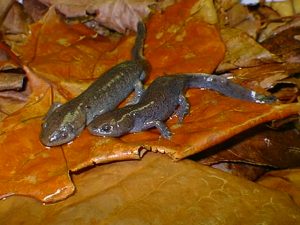 Mole Salamander (Ambystoma talpoideum)
Mole Salamander (Ambystoma talpoideum)
The Mole Salamander as its name implies spends most of its time underground. They are large headed with dark brown, black or dark gray bodies with lighter irregular speckling. The underside of the spotted salamander is pinkish gray. This 8–10 cm (3–4 in) long salamander is typically seen following late fall, winter and spring rains. They are often found under rotten logs or in breeding ponds. The mole salamander feed on a variety of small invertebrates. Mole salamanders are commonly found at the field station in ponds living as neotenic adults. These individuals are aquatic adults that are sexual mature yet still retaining their larval features such as gills.
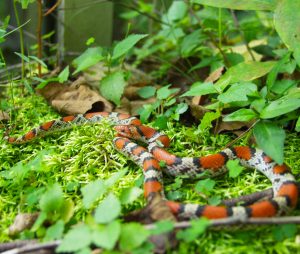 Scarlet snake (Cemophora coccinea)
Scarlet snake (Cemophora coccinea)
The Scarlet snake is a non-venomous native of the southeastern United States. They are small, secretive and semi-fossorial snakes; about 36-666 cm long (14-26 inches). Scarlet snakes are light gray or cream with black bordered red blotches down their length. Their shouts are typically red. The pattern may appear to be banding like the coral snake or scarlet king snake however in the scarlet snake the belly is always base color. Scarlet snakes maybe found in hardwood, mixed, or pine forest/woodland and adjacent open areas with sandy or loamy well-drained soils. They feed on lizards, salamanders, small rodents, reptile eggs and other snakes. Scarlet snakes lay eggs (3-8) at the Field Station throughout the spring that hatch in early fall.
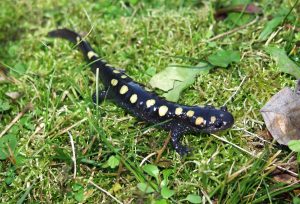 Spotted Salamander (Ambystoma maculatum)
Spotted Salamander (Ambystoma maculatum)
The Spotted Salamander is a member of a group of salamanders, called mole salamanders, that spend most of its time underground. They are black with two rows of yellow spots running the length of their bodies. The underside of the spotted salamander is pinkish gray. This 15–25 cm (5.9–9.8 in) long salamander ventures out of the only to feed and mate so typically they are found under rotten logs or in breeding ponds. The spotted salamander are nocturnal feeding on diet crickets, worms, insects, spiders, slugs, centipedes, and millipedes which they hunt at night. Spotted salamander have two large poison glands at the back of their heads which excrete a noxious milky substance when threatened or disturbed. Like some lizards they may loose their tails (autotomy) to escape a predator which is regenerated.
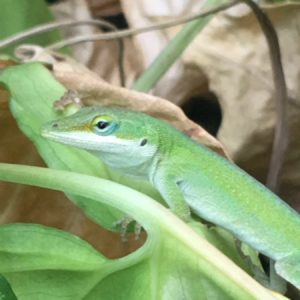 Carolina Anole Anolis carolinensis
Carolina Anole Anolis carolinensis
Sometimes referred to as the American chameleon because of its ability to change color from green to brown, the Carolina anole is commonly found on the Field Station throughout the spring, summer and fall. Anoles are medium sized lizards, 12.5–20.3 cm (4.9–8.0 inches) in length. Much of their body length is comprised of tail. Males tend to be larger than females and have a bright red dewlap that is three times the size of the females white one. While often referred to as a chameleon anoles are more closely related to iguanas. Occasionally, about one in every 20,000 individuals, a mutation occurs that reduces or eliminates xanthophores (red pigment containing cells) resulting in a blue or baby-blue individual. Males are highly territorial and will flash their red dewlaps to warn away rival males.
Red-spotted Purple Limenitis arbemis
The red-spotted purple is a common butterfly of the UM Field Station twice a year in May-June and August-September. It differs from the other “dark” swallowtails in that it has orange spots along the margin of the front wings but has no tails. The red-spotted purple belongs to the family of brush-footed butterflies and is common throughout much of the eastern United States. Males are generally a little larger than females, otherwise the two are identical. Red-spotted purples are active in the day, from morning until just after dusk. Their caterpillars feed on willow, birch, cottonwood and American hornbeam.
Lubber Grasshopper Romalea microptera (Beauvois)
The Lubber Grasshopper is a common resident of the Field Station during the late summer and early fall. Its large size (76 mm or about 3 inches), distinctive black coloration with bright red, orange or yellow stripes and short wings make them easily differentiated from other grasshoppers. Flightless and weak jumpers; these insects tend to walk rather hop. Their common name lubber is likely derived from an old English word “lobre” which means lazy or clumsy. Poor mobility and bright colors would seem to put the lubber grasshopper at risk of predation however the toxic plant material this grasshopper feed on imparts a foul and toxic flavor that most predators try to avoid. One of the few animals reported to eat lubbers is the loggerhead shrike, which eat the grasshopper after having impaled it upon a thorn for a few days.
